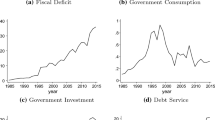Abstract
Local governments are subject to severe stress in periods of rapid change such as boom town growth - a common problem of both rural and urban towns in the sunbelt. We quantify this stress by measuring, with an econometric model, the budget deficits and the inadequacy of public facilities resulting from growth. The model emphasizes capital adjustment costs and bureaucratic inertia which slow the response of government budgets to the changing demands of their citizens. The efficacy of existing intergovernmental aid programs and other policies in mitigating growth-related problems is evaluated.
Similar content being viewed by others
References
Albrecht, Stan L. (1982). “Commentary,” Pacific Sociological Review 25: 275–296.
Barro, Robert J. (1973). “The control of politicians: An economic model,” Public Choice 14: 19–42.
Bender, Bruce and Steven Shwiff (1982). “The appropriation of rents by boomtown governments,” Economic Inquiry 20: 84–103.
Bergstrom, Theodore C. and Robert P. Goodman (1973). “Private demand for public goods,” American Economic Review 63: 280–296.
Berndt, Ernest R. and N. Eugene Savin (1975). “Estimation and hypothesis testing in singular equation systems with autoregressive disturbances,” Econometrica 43: 937–957.
Brookshire, David S. and Ralph C. d'Arge (1970). “Adjustment issues of impacted communities, or are boom towns bad?” Natural Resources Journal, July, pp. 523–546.
Crecine, John P. (1969). Government Problem-Solving: A Computer Simulation of Municipal Budgeting. Chicago: Rand McNally.
Cummings, Ronald G. and Arthur F. Mehr (1977). “Investment for urban infrastructure in boom towns,” Natural Resources Journal, April, pp. 223–240.
Cummings, Ronald G. and William D. Schulze (1978). “Optimal investment strategy for boom towns: A theoretical analysis,” American Economic Review 68: 374–385.
Davenport, Judith A. and Joseph Davenport (eds.) (1979). Boom Towns and Human Services. Department of Social Work, University of Wyoming, Laramie.
Deacon, Robert R. (1978). “A demand model for the local public sector” Review of Economics and Statistics 45: 184–191.
Durbin, James (1970). “Testing for serial correlation in least-squares regressions when some of the regressors are lagged dependent variables,” Econometrica 38: 410–421.
Filimon, Radu, Thomas Romer and Howard Rosenthal (1982). “Asymmetric information and agenda control: The bases of monopoly power in public spending,” Journal of Public Economics 17: 51–71.
Inman, Robert P. (1979). “The fiscal performance of local governments: An interpetive review,” in: Peter Mieszkowski and Mahlon Straszheim (eds.), Current Issues in Urban Economics. Baltimore: Johns Hopkins University Press, pp. 270–321.
Lee, Roger D. (1983). “An anlysis of state engergy impact mitigation programs in Colorado, Utah, Montana and Wyoming,” Journal of Energy Law and Policy 3: 281–328.
McGuire, Martin (1975). “An econometric model of federal grants and fiscal responses,” in: Wallace E. Oates (ed.), Financing the New Federalism. Washington: Resources for the Future.
Myler, Glade A. (1982). “Mitigating boom town effects of energy development: A survey,” Journal of Energy Law and Policy 2: 211–235.
Nerlove, Marc (1971), “Further evidence on the estimation of dynamic economic relations from a time series of cross sections,” Econometrica 39: 359–382.
Niskanen, William (1975). “Bureaucrats and politicians,” Journal of Law and Economics 18: 617–643.
Pommerehne, Wehner W. (1978). “Institutional approaches to public expenditure: Empirical evidence from Swiss municipalities,” Journal of Public Economics 9: 255–280.
Romer, Thomas and Howard Rosenthal (1979). “The elusive median voter,” Journal of Public Economics 12: 143–170.
Theil, Henri (1975). Theory and Measurement of Consumer Demand. Amsterdam: North Holland.
Wallace, T. D. and Ashiq Hussain (1969). “The use of error components models in combining cross section with time series data,” Econometrica 37: 55–72.
Wildavsky, Aaron (1975). Budgeting: A Comparative Study of Budgetary Processes. Boston: Little Brown.
Wilkinson, Kenneth P., et al. (1982). “Local social disruption and Western energy development: A critical review,” Pacific Sociological Review 25: 275–296.
Author information
Authors and Affiliations
Rights and permissions
About this article
Cite this article
Kiefer, D., Miller, J. Public budgets and public capital in boom towns. Policy Sci 16, 349–369 (1984). https://doi.org/10.1007/BF00135954
Issue Date:
DOI: https://doi.org/10.1007/BF00135954




